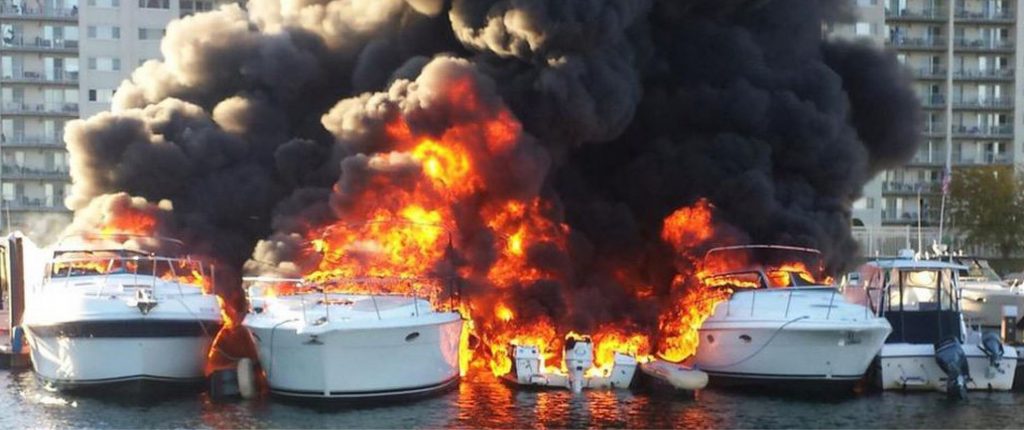Submitted by U.S. Power Squadron Past District Commander Susan Ryan JN of Old Greenwich, CT

Knowledge of safe refueling procedures can help prevent incidents like this one. Photo courtesy Quincy Police
Every week or so in summer there seems to be a boating accident of some kind – many of which can be avoided if safe boating tenets were adhered to. Each year the statistics on boating accidents and fatalities tell the same story about the thousands of accidents nationwide. The four most striking similarities are:
° Most accidents involve open boats 24 feet and under
° Over 85% of boating deaths are due to drowning
° Over 85% of drowning victims were not wearing life jackets
° Over 80% of boating fatalities involved those who had not taken a safe boating class
With this staggering evidence in front of us, we can see a potential accident waiting to happen every time a boat with uneducated people on board leaves shore. Readers may remember the fire at Stamford Harbor’s West branch in Stamford, CT last October. The fire ignited after the boat operator started the engine following refueling and spread to several nearby boats. The accident report did not suggest any operator negligence, but how many new boaters are aware of correct refueling procedure? Do they know to turn on their blower for at least four minutes after refueling?
The immediate impact of the COVID-9 pandemic was that boat dealer inventories were stagnant and the population was so distracted by the coronavirus that sales were nearly non-existent. State boat registration offices were closed or backed up, so new boat registration statistics were dismal. But after a few months of being cooped up, people began looking for ways to stay in their family unit while engaging in more exciting adventures, and boat dealers started to see a brisk uptick in boat sales – primarily of boats 18 to 27 feet.
Boating has emerged as a safe form of outdoor recreation and an ideal social distancing activity for families – but how safe is it? As Andy Cummings, District Educational Officer of America’s Boating Club (BoatGreenwich.org), says, “My ideal is for every powerboater, sailor, kayaker, tuber, water-skier, paddleboarder and jet skier to have basic boating education.” His team of expert instructors gives the class that qualifies for a Connecticut Safe Boating Certificate in a fun, interactive way.
This year, the course will be given virtually by webex on Saturday, March 13. The price is $80 per student, and registration can be online at https://tinyurl.com/ABC3131, by phoning Susan Ryan at 203-998-1864, or by emailing GreenwichSquadron@gmail.com. There’s a lot of material to cover in one day, so students must register in advance in order to read the materials ahead of class. ■




